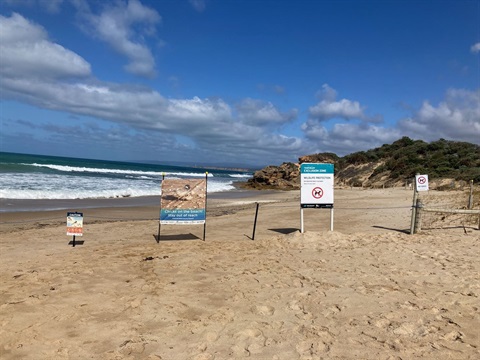Surf Coast welcomes hooded plover chicks
Published on 01 October 2024

Locals and visitors are urged to follow precautions to help ensure the survival of precious Hooded Plover chicks recently hatched at Point Roadknight and a new nest site at Lorne, along the Great Ocean Road.
With a survival rate of just 2.5%, the Great Ocean Road Coast and Parks Authority has established Exclusion Zones at Point Roadknight beach and near the Erskine River in Lorne to protect these vulnerable birds.
Both temporary Exclusion Zones are clearly marked with signage to alert the public to help protect the birds and their nest sites.
As crowds flock to Victoria’s Surf Coast beaches during the School Holidays, these plucky little plovers need our support to give their chicks the best possible chance of survival.
Beachgoers are reminded that Point Roadknight point and backbeach is a designated NO DOG zone year-round, while dogs are permitted on leash at the Lorne foreshore outside of the summer months.
Hooded plovers face multiple threats to their survival. Inclement weather and high tides can wash away nests; while predators, like larger birds, cats and foxes prey on the eggs and chicks. Human and dog disturbances can prevent parent birds from incubating eggs and feeding their young as they try to steer perceived threats away.
We manage seven breeding areas within the Surf Coast at Whites Beach, Point Roadknight, west of Point Roadknight tip, Anglesea, Fairhaven, Moggs Creek and Lorne.
Throughout the necessary protection period, our dedicated Conservation team, along with DEECA Barwon South West, Surf Coast Shire Council, Victoria Police, and volunteers, will be closely monitoring the Exclusion Zones.
We’re asking the public to:
• Keep a respectful distance. Please take your dog at another beach, or at least well outside the Exclusion Zones.
• Please be vigilant in the area. The chicks will begin feeding immediately after hatching and will use the whole beach including the intertidal zone and foredune, potentially outside the Exclusion Zone.
• Remember that their only defence is to hide in the sand. When hiding, they aren’t feeding, which is critical to their growth and development.
Quotes attribute to Acting Director Environment and Coastal Operations Leia Howes:
“This is heartwarming news, but we all need to work together to keep these hoodie chicks safe because the odds are stacked against them.
For these cute little birds to survive, they’ll need to make it through the first 35 days before they can fly and escape predators.
It’s very rare for chicks to survive this hatching stage, so we urge everyone to do their part, especially by walking dogs in other areas.
We’ve had fantastic cooperation from the community and local volunteers during previous temporary Exclusion Zones, and we’re hopeful for the same support this time around.”